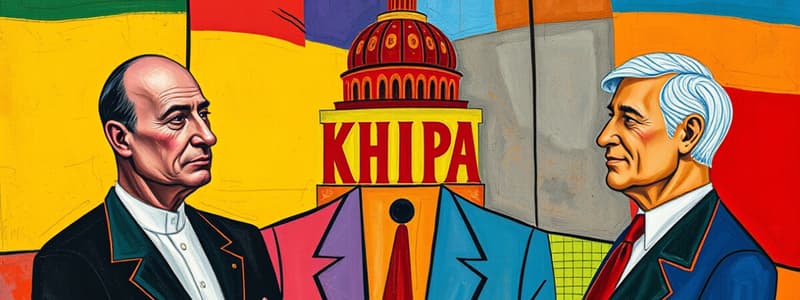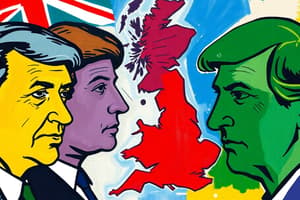Podcast
Questions and Answers
What is a multiparty system?
What is a multiparty system?
- A system with only independent candidates
- A system with two political parties
- A system that prohibits any political parties
- A system with three or more political parties (correct)
What is a pluralistic society?
What is a pluralistic society?
A society with two or more ethnic groups or nationalities organized into one state while maintaining cultural differences.
What is meant by 'party in power'?
What is meant by 'party in power'?
The party that controls the executive branch of government in American politics.
What defines a minor party?
What defines a minor party?
What is split-ticket voting?
What is split-ticket voting?
What is a one-party system?
What is a one-party system?
What does consensus mean?
What does consensus mean?
What are splinter parties?
What are splinter parties?
What is a single-member district?
What is a single-member district?
What characterizes a two-party system?
What characterizes a two-party system?
A plurality is more than half the votes cast.
A plurality is more than half the votes cast.
A ward is a unit into which cities are often divided for the election of city council members.
A ward is a unit into which cities are often divided for the election of city council members.
An ideological party arises over a particular issue or crisis and then fades away.
An ideological party arises over a particular issue or crisis and then fades away.
Partisanship means membership in one of the major parties.
Partisanship means membership in one of the major parties.
What is the major function of a political party?
What is the major function of a political party?
Do political parties in American politics serve as divisive or unifying agents?
Do political parties in American politics serve as divisive or unifying agents?
Briefly explain two ways in which American government is governed by party.
Briefly explain two ways in which American government is governed by party.
In what two ways does the American electoral system tend to promote a two-party system?
In what two ways does the American electoral system tend to promote a two-party system?
How can the diversity of views in a multiparty system be seen as both a strength and a weakness?
How can the diversity of views in a multiparty system be seen as both a strength and a weakness?
How is the ideological consensus of the American electorate reflected in the membership of the major parties?
How is the ideological consensus of the American electorate reflected in the membership of the major parties?
Which political party was the first to appear in the United States, and who was its leader?
Which political party was the first to appear in the United States, and who was its leader?
How did the Republican Party begin, and what makes its development unique?
How did the Republican Party begin, and what makes its development unique?
What effect did the Great Depression have on American political parties?
What effect did the Great Depression have on American political parties?
What unusual feature characterizes the present era of political party dominance?
What unusual feature characterizes the present era of political party dominance?
Briefly describe the four types of minor parties.
Briefly describe the four types of minor parties.
What have been the most important roles of minor parties historically?
What have been the most important roles of minor parties historically?
Why is the party in power more cohesive than the opposition party?
Why is the party in power more cohesive than the opposition party?
Describe the role of the national chairperson.
Describe the role of the national chairperson.
List and explain four factors that have contributed to the weakened state of major parties.
List and explain four factors that have contributed to the weakened state of major parties.
Flashcards are hidden until you start studying
Study Notes
Multiparty Systems
- Involves three or more political parties gaining governmental control, either independently or through coalitions.
Pluralistic Society
- Comprises multiple ethnic groups or nationalities organized within a single territorial state while preserving cultural distinctions.
Party in Power
- Refers to the political party that controls the executive branch in American politics.
Minor Party
- A smaller political entity often dependent on a charismatic leader; may persist ideologically over time, also known as a third party.
Split-ticket Voting
- Occurs when voters select candidates from different parties for various offices in a single election.
One-party System
- A governance model where only one political party is legally permitted to form the government, usually per constitution guidelines.
Consensus
- Represents a general agreement among individuals or groups on a particular issue.
Splinter Parties
- Formed when factions break away from major political parties, typically due to ideological differences.
Single-member District
- A voting system where an individual is elected from a specific geographic area, known for simplifying election outcomes.
Two-party System
- Dominated by two primary political parties, this system influences almost all electoral levels in the U.S.
Political Concepts
- A plurality refers to the most votes cast, not necessarily a majority.
- Wards serve as divisions for electing city council members, structuring local governance.
Political Party Functions
- Major roles include policy development and leadership selection, promoting national unity among differing opinions.
American Electoral System
- Creates a two-party tendency rooted in the framers’ desire to establish a cohesive nation post-1780s upheaval.
Multiparty System Strengths and Weaknesses
- Offers diverse viewpoints during elections but may lead to governmental instability compared to a two-party framework.
Ideological Consensus
- American major party membership reflects a broad ideological agreement shaped by the electorate.
First Political Parties
- The Federalists, led by Hamilton, emerged as the first U.S. political party favoring a strong central government in 1787.
Republican Party Origins
- Founded by Abraham Lincoln, it championed equality and civil rights while opposing the Democratic opposition during its early years.
Great Depression Impact
- Revived the Democratic Party’s influence and shifted national perspectives on government regulation of social and economic spheres.
Era of Divided Government
- Characterized by neither political party maintaining consistent control over the presidency or Congress.
Types of Minor Parties
- Ideological parties (belief-based), single-issue parties (focused on one policy), economic protest parties (economic discontent), and splinter parties (offshoots of major parties).
Historical Roles of Minor Parties
- The Progressive Party, led by Roosevelt in 1912, exemplifies minor parties' historical impact, winning significant electoral votes.
Cohesiveness of Party in Power
- The party in power tends to be more unified in beliefs compared to the opposition, which may exhibit individual variations.
Role of National Chairperson
- Manages the political party's headquarters and oversees organizational responsibilities.
Factors Weakening Major Parties
- Decrease in party affiliation, increase in split-ticket voting, structural reforms, and advancements in campaign technology have all contributed to the decline of major parties' cohesion and influence.
Studying That Suits You
Use AI to generate personalized quizzes and flashcards to suit your learning preferences.




